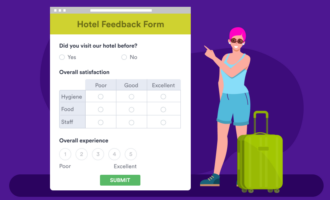Steps to improve your customer service process
- Document the current workflow
- Identify pain points
- Gather customer feedback
- Define improvement goals
- Implement enhancements
- Train your team on updates
- Pilot test and refine changes
- Monitor and adjust performance
A customer service process is a series of steps a business takes to address and resolve customer inquiries, complaints, and feedback. This systematic approach ensures consistency and quality in every customer interaction.
A well-defined customer service process is critical for improving customer satisfaction, fostering loyalty, and streamlining operations. Streamlined workflows allow businesses to resolve issues faster, reduce errors, and enhance the overall customer experience.
Key components of an effective customer service process
To build a strong foundation for your customer service management, focus on the following essential components:
- Customer communication channels: Ensure your customers can reach you via multiple channels, such as email, live chat, phone, and social media. Having multiple communication options available allows for accessibility and convenience.
- Issue resolution protocols: Establish clear guidelines for resolving different types of customer issues. Empower your team with resources and decision-making authority to provide quick and effective solutions.
- Feedback loops: Continuously gather and analyze customer feedback to understand their needs and improve your service. Feedback loops create a two-way communication channel, showing that you value customer input.
- Team training and knowledge sharing: Regularly train your customer service team on best practices, product updates, and tools to maintain a high standard of support.
- Technology and automation: Use tools like customer service automation to reduce manual effort and streamline repetitive tasks. This allows your team to focus on addressing complex customer concerns.
These components work together to create a cohesive and efficient customer service workflow that supports business goals.
Pro Tip
Strengthen your customer service process with Jotform AI Agents by automating responses, guiding customers through inquiries, and streamlining issue resolution across multiple channels.
Steps to improve your customer service process
Mapping and refining your customer service process requires a systematic approach. Follow these steps to identify areas for improvement:
1. Document the current workflow
Creating a clear and detailed map of your current customer service process is a great place to start. Begin by outlining every step, from the moment a customer makes contact to the resolution of their issue. This should include
- Communication channels: Identify all platforms customers use to connect with your team (e.g., email, chat, social media, phone).
- Team roles and responsibilities: Clearly define who is responsible for each step in the process to eliminate overlaps or confusion.
A visual flowchart or process diagram can be especially helpful for identifying potential gaps or inefficiencies in the current workflow.
2. Identify pain points
Analyze your documented workflow to spot bottlenecks, inefficiencies, and areas where customers may face challenges. For example:
- Are response times significantly longer during peak hours?
- Do customers frequently need to repeat information when transferred between agents?
- Are escalation protocols unclear, causing delays in resolving complex issues?
By pinpointing these problem areas, you can prioritize which issues require immediate attention and make sure resources are effectively allocated.
3. Gather customer feedback
Your customers’ experiences offer invaluable insights into your service strengths and weaknesses. To collect feedback:
- Conduct customer surveys with targeted questions about their recent interactions.
- Organize focus groups to dive deeper into recurring issues or preferences.
- Schedule one-on-one interviews with key customers to gather qualitative feedback.
This information helps not only in identifying hidden problems, but also in understanding customer expectations, preferences, and pain points that may not be immediately visible in workflow analysis.
4. Define improvement goals
Set clear, measurable objectives that address the issues you’ve identified. Effective goals should follow the SMART criteria:
- Specific: Define what exactly you want to achieve (e.g., “Reduce ticket resolution time”).
- Measurable: Include metrics to track progress (e.g., “Reduce first response time by 20 percent within three months”).
- Achievable: Ensure the goals are realistic given your resources and constraints.
- Relevant: Align goals with broader organizational priorities (e.g., “Increase customer retention rates”).
- Time-bound: Set deadlines to keep the team focused and accountable.
5. Implement enhancements
Once goals are set, introduce changes to address the identified issues. Potential enhancements may include
- Technology upgrades: Implement chatbots for quicker response times or adopt CRM systems to streamline data access.
- Process improvements: Simplify ticket escalation protocols or redesign workflows to reduce redundant steps.
- Team restructuring: Realign roles or create specialized teams for specific tasks to improve efficiency.
Ensure that any changes are aligned with your goals and communicated clearly to the team.
6. Train your team on updates
New processes and tools are only effective if your team understands how to use them. Comprehensive training programs should include
- Hands-on workshops: Allow team members to practice using new tools or systems in real-world scenarios.
- Resource materials: Provide guides, FAQs, and step-by-step instructions for reference.
- Regular feedback sessions: Create opportunities for the team to share concerns, ask questions, and provide input on new processes.
By empowering your team with knowledge and confidence, you set them up for success.
7. Pilot test and refine changes
Before rolling out changes organization-wide, test them on a smaller scale. This pilot phase allows you to
- Evaluate the effectiveness of new tools or processes
- Identify unforeseen challenges or issues
- Gather data to measure success and refine as needed
For example, you might implement a new escalation protocol in one department and monitor its impact before expanding it company-wide.
8. Monitor and adjust performance
Tracking key performance indicators (KPIs) is essential for assessing the effectiveness of your customer service process. Focus on the following metrics:
- Customer Satisfaction Score (CSAT): Measure customer happiness with individual interactions by asking them to rate their experience.
- Net Promoter Score (NPS): Gauge customer loyalty by asking how likely they are to recommend your business to others.
- First Response Time (FRT): Track the average time it takes for your team to respond to a customer inquiry.
- Resolution time: Monitor the time it takes to resolve a customer issue from start to finish.
- Ticket volume and trends: Analyze the number of support requests over time to identify patterns and allocate resources effectively.
Regular reviews allow you to identify emerging issues and make adjustments to maintain or improve performance. Incorporate customer feedback and team input into this ongoing process for long-term success.
Streamline customer service with Jotform
Jotform is your all-in-one solution for transforming customer service management into a seamless and efficient process. Whether you need to register new customers, offer special discounts, or gather valuable feedback, Jotform’s versatile tools have you covered.
With Jotform’s Net Promoter Score (NPS) survey builder, you can effortlessly collect customer loyalty insights from any device. Create custom feedback forms to understand better how your customers perceive your services and products. By using Jotform’s conditional logic, you can trigger surveys automatically after specific interactions, ensuring you gather timely and relevant feedback.
Stay on top of customer service requests with automated email notifications that alert you the moment a customer submits a form. Additionally, Jotform Report Builder helps you analyze collected data, helping you to identify common service challenges, monitor resolution times, and refine your offerings for improved customer satisfaction.
From streamlining daily operations to enhancing customer engagement, Jotform equips you with the tools to deliver exceptional service and build lasting customer relationships.
Optimizing your customer service process is essential for enhancing customer satisfaction, improving efficiency, and supporting business growth.
You can create a customer-centric service strategy by focusing on key components, mapping and refining workflows, and leveraging metrics to measure success. Tools like Jotform make automating processes, gathering feedback, and tracking performance easier, ensuring your customer service operations are always at their best.
Photo by MART PRODUCTION





















Send Comment: